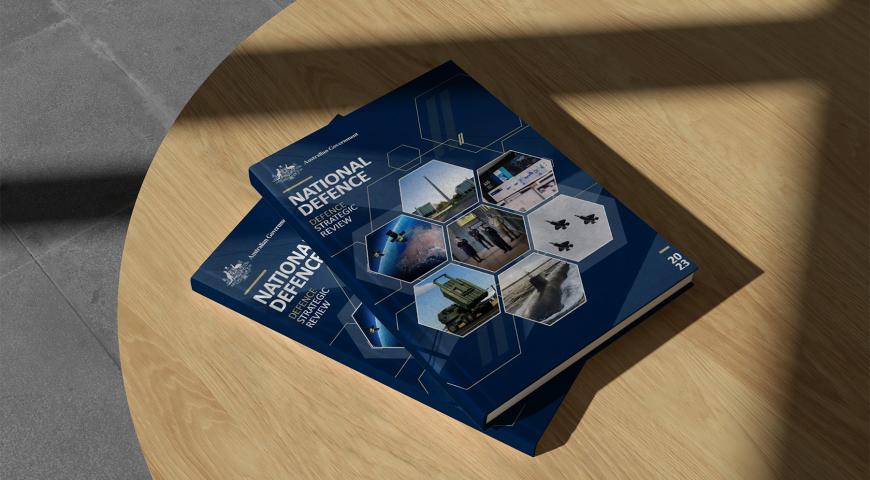Introduction
The Australian Defence Force (ADF) is underpinned by an ethical framework that has evolved over the course of its history. This framework supports what may be called the ‘ethical ecosystem’ that is the living day-to-day decision making, thought, and action of all Defence members. Inevitably, the health of this ethical ecosystem will rely on more than just the ADF’s communicated intent and enforced policy, it will be an ever changing reality interacting with broader Australian society, international military theory, the character and beliefs of individual ADF members, and a myriad of other factors. Nevertheless, the established ethical framework is undoubtedly its core foundation. Going into the future, the ADF will face new challenges, unprecedented in its historical experience, that will require it to continue to adapt and refine its ethical principles and practice.
The ADF Philosophical Doctrine on Military Ethics (ADF-P-0 ME) is the cornerstone document that outlines the ADF’s ethical theoretical basis. The ADF-P-0 ME presents three ethical theories that align with Defence’s ethical approach and two that are consciously rejected as being out of alignment. The three that align are duty ethics (also referred to as deontological ethics), virtue ethics, and natural law.[1] Duty ethics and natural law theory have a focus on the intent of an action. Virtue ethics focuses on moral identity as a guide for behaviour. The two ethical theories that are expressly rejected are consequentialist ethics and relativism. Consequentialist ethics focuses on the consequences of an action rather than the intent or action itself. While the doctrine clarifies that ‘thinking about the likely outcomes of our actions is essential’,[2] it rejects this ethical theory on the basis that the dangers of ‘the means justifying the ends’ are unacceptable. Relativism is the rejection of objective ethical value separate from individual context. The ADF is clear that it holds high regard for objective ethical value and expects its members to act in accordance with shared values. The ADF-P-0 ME acknowledges the complexities of ethical considerations and the limitations of isolated ethical theories, clarifying that: ‘Ethics is not maths. There is no simple formula. What matters is that people are thoughtfully applying these values to ensure we have an ethical culture.’[3]
Specific to the conduct of war, the ADF respects the Just War tradition. Just War theory is traditionally comprised of two subsections: Jus ad Bellum and Jus in Bello. Jus ad Bellum defines the ethical requirements for going to war as Just Cause, Right Intention, Legitimate Authority, Proportionality, Probability of Success, and Last Resort.[4] Jus in Bello defines ethical conduct in war as following the principles of discrimination, proportionality,[5] military necessity and humanity.[6] More recently, the concept of Jus post Bellum has been proposed to define ethical responsibilities following a war. A similar framework of Jus ad Vim (and the parallel Jus in Vi and Jus post Vim) has been proposed to define ethical responsibilities in the use of force short of war.
The theoretical ethical basis outlined in ADF-P-0 ME places a clear focus on the intent of actions and the character of individuals. Character as a foundational concept is further expanded on in the complementary philosophical doctrine, ‘Character in the Profession of Arms’.[7] The ADF also promotes five values and six behaviours to its members.
These values are:
- Service
- Courage
- Respect
- Integrity
- Excellence
The behaviours are:
- Act with purpose for Defence and the nation.
- Be adaptable, innovative and agile.
- Collaborate and be team-focused.
- Be accountable and trustworthy.
- Reflect, learn and improve.
- Be inclusive and value others.[8]
Legally, the ADF and its members are governed by international law, including significantly the Law of Armed Conflict (LoAC), also called International Humanitarian Law (IHL), and all treaties to which Australia is party. Within IHL, of particular interest to the ethics of emerging concerns is the Martens Clause, which specifies that in situations not explicitly covered by IHL, ‘the principles of the law of nations, the laws of humanity, and … the dictates of public conscience’ have legal weight.[9] The ADF is also subject to all domestic laws relevant to its activities. It should be made clear that legal actions and ethical actions are not interchangeable concepts.[10] The ADF-P-0 ME has to say on the matter: ‘Acting in accordance with the law is generally considered to be a minimum standard of ethical behaviour. Complying with the law is necessary and meets our fundamental duties, but it is not always sufficient by itself.’[11] Nevertheless, the legal framework that the ADF operates in provides valuable context and insight into navigating principles when approaching ambiguous ethical issues.
The structure of this essay will take the form of a discussion on some of the current and impending ethical challenges by grouping them into four broad umbrella topics. These topics are:
- Environment – The natural environment is facing accelerating degradation and instability. Environmental ethical issues are characterised by complex consequential chains and blurred impacts across geographical and intergenerational lines, challenging the traditional relationship between the ADF and the natural world.
- Technology – While technological advantage has always been a deciding factor in warfare, the rate of progress in the field is accelerating and the complexities of new capabilities raise new and urgent ethical questions as to their development and uses.
- Role – Much of the ADF’s ethical framework evolved in an era when its role was to provide kinetic force in conventional state-based warfare. While this is still part of the ADF’s purpose, the current geopolitical context, contemporary nature of conflict, and other pressures have expanded and diversified the role of the modern ADF.
- Culture – Attitudes to ADF member interactions and internal ethical considerations have shifted over time, as have the wider contexts of Australian society and global military mores. These have come under particular scrutiny in light of recent and widely publicised ethical failings in the organisation.
It is important to be clear on why the ADF should be an ethical organisation and require its members to commit to ethical actions. Many highlight the strategic benefits of ethical conduct, whether in domestic recruiting, building international trust, or protecting veterans from moral injury, but these consequences should never be the sole or even the main justification for ethical conduct. Ethics should be the foundation of the ADF as a means in itself. Grappling with questions of right and wrong and the obligation to do right is the rent we pay for being human, and that rent increases when we make our business the use of force against others. The real tests of the ADF’s ethical framework come when what is ethically correct and what is operationally effective are in conflict. This framework should be strong enough and clear enough that all members are both empowered and required to behave ethically even when doing so makes their job harder or puts themselves and their colleagues at greater risk.
This essay is not intended prescriptively. It will instead attempt to shine light into issues relevant to the ADF and its people and seek out questions that will challenge the existing ethical framework. The focus will be on recent and emerging issues that are in some way novel to conventional military ethics. While there is overlap, the scope of this essay does not cover enduring questions that armed forces have been dealing with for centuries, such as the morality of taking life. This essay will also steer away from discussions of strategy. While ethical health is an important strategic consideration, strategic gain should never be the sole justification for ethical behaviour. Not every contemporary issue is touched upon and no doubt there are many more unforeseen dilemmas ahead, but these four umbrella topics will hopefully give some insight into the types of concerns that are currently challenging the existing ADF framework, and the present thought around them.
Environment
On 18 January 1962, under the command of then United States President John F. Kennedy, Operation Ranch Hand was launched by the US military as part of the ongoing war in Vietnam.[12] Over the next 10 years, about 77 million litres of defoliants, predominantly the now infamous Agent Orange, were sprayed over Vietnam’s forests and agricultural land devastating the country’s natural environment and carving a breathtaking legacy of human suffering.[13] The war was described as ecocide by the then Prime Minister of Sweden and denounced on both human and environmental grounds by other world leaders.[14] Over half a century later, environmental degradation is posing some of the thorniest ethical challenges across national, socioeconomic, and generational lines. Climate change in particular, described by former Australian Prime Minister Kevin Rudd as ‘The great moral challenge of our generation’,[15] is set to dramatically alter the natural environment and human interaction with it.
Following the environmental atrocities in Vietnam, sentiment for more formalised protections coalesced into the Convention on the prohibition of military or any other hostile use of environmental modification techniques known colloquially as EnMod.[16] EnMod was signed by Australia on 31 May 1978 and now encompasses 78 states.[17] The convention explicitly bans the modification of the natural environment as a means of warfare. The environment also has implicit protection under IHL as being intrinsically civilian in character and therefore forbidden from deliberate targeting and subject to Proportionality tests where there is any risk of collateral damage.[18] The usual ambiguity of Proportionality risks being further muddied by the broad distribution, both geographically and intergenerationally, of environmental damage.
Attempts have been made to give stronger international legal protection to the environment for many decades. The drafting process for what is now the Rome Statute originally included an Article 26 that condemned any individual who ‘wilfully causes or orders the causing of widespread, long-term and severe damage to the natural environment’[19]. At the time, the article was criticised by several governments, including Australia’s, for not being strong enough to prevent aware but not wilful environmental damage as a consequence of peacetime industry.[20] Eventually, the article was entirely removed and the only environmental protection offered by the Rome Statute was Article 8 (b IV) under the heading of War Crimes, prohibiting a similarly worded crime but only within a war context, and only if ‘clearly excessive’ to military objective.[21] Likewise, the original conception of the crime of genocide was much broader than ‘simply racially-motivated mass killing’[22] and instead focused on the destruction of a people and their culture, including by means other than direct extermination, such as by destroying the environment that an indigenous people relied on.[23] More recently, some have called for a fifth Geneva convention, specific to the natural environment.[24]
Outside of international military legal obligations, Australia’s own Environmental Protection and Biodiversity Conservation (EPBC) Act governs domestic environmental concerns. This Act specifically covers ‘military exercises and use of military equipment’[25] and includes in its scope ‘representatives of Commonwealth agencies who propose to take an action that may impact on the environment anywhere in the world’.[26] The EPBC Act also offers more clarity as to how to approach the issue of unintended consequences and ambiguous or diffuse outcomes, stating: ‘If there is scientific uncertainty about the impacts of your action and potential impacts are serious or irreversible, the precautionary principle is applicable.’[27] Specific to climate, Australia is party to the United Nations Framework Convention on Climate Change (UNFCCC), the Kyoto Protocol,[28] and the Paris Agreement.[29]
The Department of Defence has published an Environmental Policy, an Environmental Strategy, and an Environmental Plan. Specifics are expanded upon in the Environment and Heritage Manual. These documents are strategic, not philosophic, and focus mainly on immediate physical environments. Still, the Policy outlines four core ‘pillars’ of Compliance, Efficiency, Trust and Accountability. Within these it specifies that, ‘Defence takes ownership of, and responsibility for, environmental outcomes when performing its activities’. As environmental outcomes risk becoming more severe and more difficult to predict, this approach leaning towards consequentialism provides relevant clarity.
Many environmental concerns are characterised by particularly diffuse and uncertain consequences spread across geographical and intergenerational lines and intersecting with numerous other factors such as poverty and social structures. The concept of intergenerational justice raises the question of what weighting the ADF gives to people who are not yet born vs people alive today. This in turn affects questions of proportionality and acceptable use of force. If potential ‘future civilians’ are given ethical weighting as current civilians are, then decisions that would affect the survival rates and quality of life of unborn people would need to take into account generationally ongoing consequences. The relative ethical weighting of a current person as opposed to a potential future person could also affect the balance of decision making.
A theoretically similar concern is the ethical weighting given to non-human beings such as animals or even non-sentient concepts such as the ‘biosphere’. As well as suffering indirectly from environmental destruction, animals are the victims of large-scale slaughter and suffering in conflict situations.[30] In the ADF, the use of live animals in medical training opened up discussion about the ethical status of animals compared to humans. Until it was phased out in 2018 in favour of artificial human models, the Early Management of Severe Trauma course involved deliberately inflicting wounds into the throats, chests, and limbs of anaesthetised animals in order to give trainees realistic experience in wound management.[31] As well as the technical skill, the emotional shock of handling a living being violently wounded was preparation for psychological challenges of treating war injuries.[32] This practice was campaigned against by animal rights groups.[33] The use of such programs indicates a willingness by the ADF to use animals as a ‘means not an end’, without the intrinsic dignity afforded to human life.
When it comes to the legal protection of non-human animals, IHL offers only limited and incidental protection where animals could be covered under environmental clauses or as civilian objects.[34] This strongly anthropocentric focus is the product of the time it was established, when animal welfare did not receive much consideration. Increasing concern for animal welfare in broader society highlights a case for more ethically rigorous protection in military contexts, particularly in light of the Martens Clause which recognises the ‘dictates of public conscience’ as a valid restricting agent in military conduct.[35] While they may be used in hostilities, the classification of animals as ‘combatants’ or ‘non-combatants’—categories currently reserved for humans—is impractical.[36] However, an ‘object’ classification does not recognise their sentience or capacity for suffering. In Australian law, there is no federal legislation explicitly on animal welfare and it is instead managed at the state level.[37]
While human life is often considered more important than animal life,[38] an extension of ethical obligation to non-human beings will shift the balance of decision making where those decisions could harm animals.[39] Again, relative weighting between human and animal suffering as well, as which species are more or less ethically significant, will impact the balance. In an ethical framework where animal ethical weighting is considered, it will also be relevant as to the root of that validity. Whether the source of ethical obligation is an intrinsic dignity, such as that afforded to humans,[40] or a broader obligation to a concept such as the ‘environment’ or the ‘biosphere’, will again affect the balance of decision making. ADF-P-0 ME does not cover ethical considerations to the natural world or non-human animals.[41]
Historically, conflict has been detrimental to the natural environment it occurs in.[42] As well as direct damage, indirect effects from issues like pollutants, population displacement, and weakening of governance can lead to ongoing damage even after hostilities have ended.[43] The concept of Jus post Bello is particularly relevant to such situations. There is also a reciprocal relationship between environmental degradation and conflict. Forced migration and competition over resources can have a destabilising effect on already vulnerable states.[44] In particular, Australia’s immediate geographical surrounding has been identified as being at increased risk of instability from climate effects.[45]
Even outside of kinetic conflict operations, the ADF is a resource-intensive industry with significant environmental impact and environmental risks. The nature of defence operations poses pollution hazards such as what occurred with per- and polyfluoroalkyl substances (PFAS) contamination around military bases.[46] Equipment procurement, training exercises, daily operations, and non-conflict engagements have the same environmental risks and resulting ethical obligations that any civilian business operation would. Like comparable militaries, the ADF is heavily reliant on liquid fossil fuels, in fact, Australia’s future nuclear-powered submarines will be the first major weapons system not reliant on it.[47] The fuelling of navy and aviation forces is particularly carbon intensive.[48] As global energy systems transition away from carbon fuels, forward thinking and collaboration with commercial sectors will be required both strategically and as part of its environmental stewardship obligations.[49] Expectation from the Australian community to operate in non-polluting ways can be expected to increase pressure on the ADF’s reliance on liquid fossil fuels.[50]
It is now also broadly accepted that the environment military activity takes place in extends into the domain of space.[51] Since 1967, the Outer Space Treaty has placed limitations on military activity in space, but with a focus on peacekeeping, not conservation. Many of its principles are modelled on its predecessor, the Antarctic Treaty, but it is less restrictive on military use, allowing conventional weapons in orbit, and ballistic missiles.[52] The concept of space as a military domain raises many similar issues of transboundary and intergenerational effects. In particular, the issue of debris, such as that from satellite destruction, has global and long-lasting consequences.[53] New technologies are also opening up the domain to non-state actors.[54] The blurring of national borders and ambiguity of actors that characterises the space domain will become increasingly pertinent as space warfare matures and will challenge ethical systems built for conventional terrestrial conflict.
Much of the discourse on the impact of military activity focuses on reducing environmental degradation,[55] but we should not neglect the possibility for military activity to bring positive outcomes for preservation and restoration of natural resources. Indeed, military force is a core part in establishing and maintaining a rules-based global order that respects laws and norms that protect the natural world. Navies are an important deterrent to illegal and destructive fishing operations and the RAN contributes to this role in collaboration with their Pacific neighbours.[56] Military technology can provide dual use value to research and conservation scientists.[57] The RAN provides meteorological and hydrographic capabilities to Antarctic research through Operation Southern Discovery.[58] The ADF also provides humanitarian aid to those in our region experiencing the impacts of natural disasters, and we can expect the necessity of this role to increase with worsening climate change.[59]
As human inflicted degradation of the natural world continues, the ethical imperative to act in environmentally sustainable and restorative ways increases. Militaries have particular challenges in doing so due to the destructive nature of conflict, technological reliance on fossil fuels, and ambiguity and gaps in current legislature. These challenges pose questions to traditional ethical frameworks across both geographical and intergenerational lines. Similar challenges arise from the consideration of non-human entities such as sentient animals capable of suffering, and broader but possibly valuable concepts such as the ‘biosphere’. Likewise, the expansion of military activity into space blurs concepts of state boundaries and generational obligation, as well as opening up technological issues that alter the warfare paradigm.
Next in Navigating New Ethical Frontiers: Part 2, Technology
1 Australian Defence Force, ADF Philosophical Doctrine - Military Ethics, https://theforge.defence.gov.au/military-ethics/adf-philosophical-doctrine-military-ethics, The Forge, 2021, accessed June 2023.
2 Australian Defence Force, ADF Philosophical Doctrine - Military Ethics, p18.
3 Australian Defence Force, ADF Philosophical Doctrine - Military Ethics, p30.
4 Australian Defence Force, ADF Philosophical Doctrine - Military Ethics, pp9-10.
5 Discrimination and Proportionality are also words used to describe legal concepts in the Laws of Armed Conflict.
6 Australian Defence Force, ADF Philosophical Doctrine - Military Ethics, p44.
7 Australian Defence Force, Character in the Profession of Arms, https://theforge.defence.gov.au/character/character-doctrine, The Forge, 2023, accessed June 2023.
8 Australian Government – Defence, Values and behaviours, https://www.defence.gov.au/about/who-we-are/values-behaviours, Defence, n.d., accessed 27 November 2023.
9 International Committee of the Red Cross, Martens Clause, https://casebook.icrc.org/a_to_z/glossary/martens-clause, How does law protect in war, 2023, accessed 29 November 2023.
10 S Coleman, New Technologies and the Law of Armed Conflict, TMC Asser Press, 2014, p30.
11 Australian Defence Force, ADF Philosophical Doctrine - Military Ethics, p6.
12 A Glass, U.S. launches spraying of Agent Orange, Jan. 18, 1962, https://www.politico.com/story/2019/01/18/us-launches-operation-ranch-hand-jan-18-1962-1102346, Politico, 18 January 2019, accessed June 2023.
13 National Academy of Sciences, Veterans and Agent Orange: Update 11 (2018), https://www.ncbi.nlm.nih.gov/books/NBK535899/, National Academies Press (US), 15 November 2018, accessed 29 November 2023.
14 A Gauger et al., Ecocide is the missing 5th crime against peace, https://hrc.sas.ac.uk/research-and-policy/environmental-justice/ecocide-project, Human Rights Consortium, School of Advanced Study, University of London 2013, accessed 12 October 2023.
15 M Hudson, It’s ten years since Rudd’s ‘great moral challenge’, and we have failed it, https://theconversation.com/its-ten-years-since-rudds-great-moral-challenge-and-we-have-failed-it-75534, The Conversation, 31 March 2017, accessed June 2023.
16 G Kolpak, From ENMOD to geoengineering: the environment as a weapon of war, https://ceobs.org/from-enmod-to-geoengineering-the-environment-as-a-weapon-of-war/, Conflict and Environment Observatory, 7 April 2020, accessed 12 October 2023.
17 Convention on the prohibition of military or any other hostile use of environmental modification techniques (New York, 10 December 1976) [1978] UNTC Chapter XXVI 1.
18 International Committee of the Red Cross, Guidelines on the protection of the natural environment in armed conflict, https://www.icrc.org/en/publication/4382-guidelines-protection-natural-environment-armed-conflict, International Committee of the Red Cross, 2020, accessed 29 November 2023.
19 A Gauger et al., Ecocide is the missing 5th crime against peace.
20 A Gauger et al., Ecocide is the missing 5th crime against peace.
21 International Criminal Court, Rome Statute of the International Criminal Court [pdf, 373KB], https://www.icc-cpi.int/sites/default/files/RS-Eng.pdf, International Criminal Court, 1998, accessed 11 November 2023
22 A Gauger et al., Ecocide is the missing 5th crime against peace.
23 A Gauger et al., Ecocide is the missing 5th crime against peace.
24 J Watts, Make environmental damage a war crime, say scientists, https://www.theguardian.com/law/2019/jul/24/make-environmental-damage-a-war-say-scientists-geneva-convention, The Guardian, 24 July 2019, accessed 28 November 2023.
25 Australian Government, Environment Protection and Biodiversity Conservation Act 1999, https://www.legislation.gov.au/C2004A00485/2021-03-28/text, Federal Register of Legislation, accessed 28 November 2023.
26 Australian Government, Environment Protection and Biodiversity Conservation Act 1999.
27 Australian Government, Environment Protection and Biodiversity Conservation Act 1999.
28 United Nations Climate Change, Parties to the United Nations Framework Convention on Climate Change, https://unfccc.int/process/parties-non-party-stakeholders/parties-convention-and-observer-states?field_partys_partyto_target_id%5B512%5D=512, United Nations, n.d., accessed 28 November 2023
29 Paris Agreement, https://treaties.un.org/Pages/ViewDetails.aspx?src=TREATY&mtdsg_no=XXVII-7-d&chapter=27&clang=_en, (12 December 2015) [2016] UNTC Chapter XXVII 7.d.
30 A Peters and J de Hemptinne A plea for "animalizing" the International Law of Armed Conflict, https://lieber.westpoint.edu/plea-animalizing-international-law-armed-conflict/, Lieber Institute, West Point, 11 October 2022, accessed 12 November 2023
31 Hospital and Healthcare, Live animals for trauma training no longer an option, https://www.hospitalhealth.com.au/content/clinical-services/article/live-animals-for-trauma-training-no-longer-an-option-271620839, Hospital and Healthcare, 28 April 2017, accessed 12 November 2023.
32 G Martinic, ‘The use of animals in live-tissue trauma training and military medical research’, Lab Animal, Volume 40 No. 10, 2011, pp319-312.
33 Hospital and Healthcare, Live animals for trauma training no longer an option.
34 A Peters and J de Hemptinne, A plea for "animalizing" the International Law of Armed Conflict.
35 International Committee of the Red Cross, Martens Clause; A Peters and J de Hemptinne, A plea for "animalizing" the International Law of Armed Conflict.
36 A Peters and J de Hemptinne, A plea for "animalizing" the International Law of Armed Conflict.
37 Animal Protection Index, Australia, https://api.worldanimalprotection.org/country/australia, Animal Protection Index, 2020, accessed 28 November 2023
38 G Martinic, ‘The use of animals in live-tissue trauma training and military medical research’.
39 A Peters and J de Hemptinne, A plea for "animalizing" the International Law of Armed Conflict.
40 The Ethics Centre, Ethics Explainer: Dignity, https://ethics.org.au/ethics-explainer-dignity/, The Ethics Centre, 2017, accessed 28 November 2023.
41 Australian Defence Force, ADF Philosophical Doctrine - Military Ethics.
42 MJ Lawrence, The effects of modern war and military activities on biodiversity and the environment, https://cdnsciencepub.com/doi/full/10.1139/er-2015-0039, Environmental Reviews, 2015.
43 International Committee of the Red Cross, Guidelines on the protection of the natural environment in armed conflict.
44 Information Resources Management Association, Research Anthology on Military and Defense Applications, Utilization, Education, and Ethics, IGI Global, 2021, p228.
45 AG Clarke, Military challenges from climate change, https://ciasp.scholasticahq.com/article/88984-military-challenges-from-climate-change, Contemporary Issues in Air & Space Power, 2023, accessed 11 November 2023.
46 R Fitzgerald, Class action against Department of Defence over alleged PFAS chemicals contamination to begin in Federal Court, https://www.abc.net.au/news/2023-05-15/pfas-class-action-begins-in-federal-court/102342356, ABC, 15 May 2023, accessed 13 November 2023.
47 U Yildirim and W Leben, The Australian Defence Force and its future energy requirements, https://www.aspi.org.au/report/australian-defence-force-and-its-future-energy-requirements, Australian Strategic Policy Institute (ASPI), 21 June 2022, accessed 2023.
48 International Military Council on Climate and Security, World climate and security report 2021, https://imccs.org/the-world-climate-and-security-report-2021/, International Military Council on Climate and Security, 2021, accessed 2023.
49 U Yildirim and W Leben, The Australian Defence Force and its Future Energy Requirements.
50 U Yildirim and W Leben, The Australian Defence Force and its Future Energy Requirements.
51 C Steer and D Stephens, International Humanitarian Law and its application in outer space, in C Steer and M Hersch (eds.) War and peace in outer space: law, policy, and ethics, Oxford University Press, 2020.
52 D Kimball, The Outer Space Treaty at a glance, https://www.armscontrol.org/factsheets/outerspace, Arms Control Association, October 2020, accessed 29 November 2023.
53 J O’Callaghan, What is space junk and why is it a problem?, https://www.nhm.ac.uk/discover/what-is-space-junk-and-why-is-it-a-problem.html, Natural History Museum, n.d., accessed 29 November 2023.
54 The impacts of new technology will be further discussed in the Technology chapter.
55 J Watts, Make environmental damage a war crime, say scientists.
56 Australian Government Defence, ADF helps tackle illegal fishing in the Pacific through Operation Solania, https://www.defence.gov.au/news-events/releases/2022-03-24/adf-helps-tackle-illegal-fishing-pacific-through-operation-solania, Defence, 24 March 2022, accessed 28 November 2023.
57 MJ Lawrence, The effects of modern war and military activities on biodiversity and the environment.
58 Australian Government Defence, Operation Southern Discovery, https://www.defence.gov.au/defence-activities/operations/southern-discovery, Defence, n.d., accessed 28 November 2023.
59 The use of the ADF for humanitarian relief and disaster response will be further discussed in the chapter on Role.
Social Mastery
Navigating New Ethical Frontiers - Part 1 - Environment © 2025 by . This work is licensed under CC BY-NC-ND![]()
![]()
![]()
![]()
Please let us know if you have discovered an issue with the content on this page.
Comments
Start the conversation by sharing your thoughts! Please login to comment. If you don't yet have an account registration is quick and easy.





